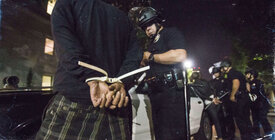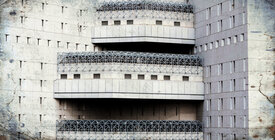This essay is part of the Brennan Center’s series examining the punitive excess that has come to define America’s criminal legal system.
How does the era of punitive excess come to an end?
In December, the city council of Charlottesville, Virginia, voted unanimously to donate the city’s statue of Confederate war leader Robert E. Lee to the Jefferson School African American Heritage Center, which proposed to melt it down and use the bronze to create “a new work of art that will reflect racial justice and inclusion.” The center’s proposal was called “Swords into Plowshares.” According to Andrea Douglas, executive director of the center, “We’re taking something that was harmful, taking something that was the source of trauma, and transforming it into something that is more respective of the democratic, community space.”
If mass incarceration is the bronze statue of punitive excess, it should now be melted down and transformed. What has been traumatic and painful should be replaced with a new vision of justice that promotes community well-being, not oppression, and celebrates democracy, not racial domination.
The era of punitive excess documented in the Brennan Center’s collection of essays represents the latest chapter in a long history of white supremacy and economic injustice, and it constitutes a multi-count indictment against the system of criminal laws created in its wake. To turn the page on this chapter, we propose an honest reckoning with the harms of punitive excess.
Reckoning requires a commitment to truth-telling, beginning with the tangle of fictions that stand in the way of change: Punishment keeps us safe, justice is found in courtrooms, conflicts are best resolved through an adversarial process, harmed parties need retribution, prisons are places for rehabilitation, punishment ends once one leaves prison, the wealthy and the poor receive equal treatment under the law. Perhaps foremost among the fictions of justice is the notion that monumental racial disparities were necessitated by patterns of crime and demanded by communities of color. A reckoning is needed to set the record straight.
Our idea of a reckoning has three key parts.
First, a reckoning is a historical project that confronts decades of penal harm that punctuated centuries of structural racism. History reveals how institutions that are charged with the task of safety have operated as instruments of control and isolation. History explains why the demographic contours of mass criminalization and incarceration align so neatly with racial exclusion and extreme poverty. The history of slave patrols, convict labor, Black codes, the terrorism of lynching, the violent suppression of Black political power after Reconstruction, the role of police and courts in enforcing white supremacy — understanding the history of all these offenses against America’s Black communities can propel the demand for a new vision of justice that empowers them.
Second, a reckoning is not just a historical reflection. An honest reckoning will also drive a different kind of political dynamic, one in which community representatives have a central role. Powered by communities that have suffered at the hands of punitive excess, a reckoning process can disrupt the status quo and challenge established political norms. We have already glimpsed the propulsive force of historical reckoning in the work of community movements to close jails, reform bail, forgive court debt, and eliminate stop and frisk in jurisdictions around the country. By articulating how the current criminal justice orthodoxy has weakened democratic ideals, deepened poverty and racism, and damaged individuals and communities, reckoning foreshadows a fundamentally different vision of justice. The recounting of historic harms will lend urgency to community demands for the realization of this new vision. We hope that the truth-telling and power-sharing that reckoning entails will promote engagement over estrangement, activism over alienation. The fertile ground of community conversation has the potential to encourage a new generation of leadership, steeled to sustain the movement from vision to reality.
Third, a reckoning must also engage the public officials who have driven the justice juggernaut. They should be enlisted in the work of fundamental change, in part because of the harm that they and their predecessors have caused. Truth-telling should provide community representatives with the chance to confront authorities with a direct account of the harm they’ve suffered and their plans for remediation. Police abuse, gratuitously long sentences, the indignity of solitary confinement, and the unpayable burden of fines and fees all deserve an accounting from the public officials who design and staff the system. The myth that safety is rooted in punishment can be powerfully exposed if community members speak to how countless police stops, arrests, and incarcerations have put them at risk. Public officials must also be engaged for the pragmatic reason that they sit squarely in the vanguard of inertia and resistance. A truth-telling process that invites their participation will provide opportunities for some officials to become champions for change. In a struggle for fundamental transformation, the voice of the convert has zeal and unique credibility.
In its most successful version, a reckoning opens the window for policies that disrupt the logic of punitive excess. Communities themselves would have a much stronger hand in designing how and for whom safety is achieved. The pursuit of justice would draw upon community strengths to advance the goals of healing and forgiveness. The accountability of public officials would reflect a commitment to transparency and civilian authority. Sanctions for those community members who harm others would show unwavering respect for their value and dignity and be proportionate to the harm they’ve committed.
Disrupting the logic of punitive excess by reckoning with the legacy of white supremacy is as much a process as it is an outcome. A sustained dialogue that is steeped in history, led by the voice of impacted communities, and confronts officials with the harms they have caused or perpetuated will sometimes be halting, and often frustrating. But, we hope, such a process can enable fundamental change by sharing power and broadening the coalition for change. Such a process compels a new politics of justice.
A reckoning will necessarily probe the significant trauma and harm caused by the agencies of the justice system, harms so powerfully detailed in this series of essays. Beyond enumerating these harms, an honest reckoning will also ask whether the police and penal institutions that claim responsibility for safety have actually provided it. This is especially important today, when gun violence and homicide are on the rise. At a time when we see the failure of punitive excess clearly, the upward trend in crime somehow nourishes the status quo. A reckoning with history will reveal the paradox that reliance on police and prisons has yielded significant trauma and harm, and the promise of safety and community well-being remains elusive. We must settle accounts with history in order to create a different kind of safety that answers the threat of violence, makes communities stronger, and advances a new vision of justice.
Skeptics will say that this utopian vision of justice is unattainable in America. We understand the many political forces arrayed against such a vision. A racist and authoritarian ideology is deeply embedded in our justice system. A large portion of the public views tough-on-crime policies as effective answers to crime and disorder. The justice juggernaut is sustained by powerful economic interests and entrenched career incentives. Community residents who strive for public safety also regularly turn to police and prisons for help — but this reflex itself arises in a context where residents often have few alternatives to choose from. We believe that by empowering the voices of communities experiencing harm, mobilizing coalitions to influence public policy, and telling the truth about punitive excess, a reckoning process can counter the forces of opposition.
We recognize that the road to dismantling systems of injustice is long and that progress is not linear. We also believe that dismantling the sturdy architecture of punitive excess will require more than marginal reforms. The statue must be taken off its pedestal, melted down, and recast as something new.
History teaches us that a reckoning with history happens only rarely, and then often in the context of painful regime change, such as a defeat in war, a political revolution, or accumulated moral outrage. One need only consider the history of the Truth and Reconciliation Commission in post-apartheid South Africa, the establishment of a democratic Germany following the horrors of the Holocaust and the revelations of the Nuremberg trials, or America’s own brief experiment with racially inclusive democracy in Reconstruction before it was destroyed by a century of resurgent white supremacy. These and other examples of nations coming to terms with their historical injustices underscore the complexity — and necessity — of a process of reckoning as a precondition for a new kind of justice.
A reckoning does not determine precisely how the swords of punitive excess are beaten into the plowshares of community empowerment, but we hope it creates a space for such a political process to begin. This process embodies the values of dignity, democracy, and truth-telling. It actively pursues the promise of a multi-racial democracy. These values, when infused into a political dialogue, have the transformative power to eclipse the era of punitive excess.
Jeremy Travis is executive vice president of criminal justice at Arnold Ventures. Bruce Western is a professor of sociology at Columbia University and director of the Columbia Justice Lab. They are cofounders of the Square One Project at the Columbia Justice Lab. The views expressed here are not necessarily those of Arnold Ventures.






